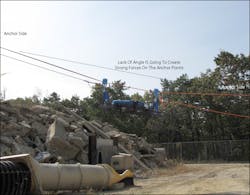This month’s article continues our focus on an advanced skill in the world of rope rescue; that skill being tensioned highlines. Tensioned highlines can be a useful skill in the wilderness and even an urban setting. Whatever the setting, the need is the same — to get a patient or “victim” from point A to point B safely, effectively, and efficiently (remember the acronym SEE?).
There is a lot more to tensioned highlines than two ropes between two points. In this article, I’ll break down that information for you to hopefully show you that with a little thinking and planning tensioned highlines not too difficult.
There are several different ways to construct these systems, but I will focus on one method that I feel works the best and have had success teaching.
Highlines can be categorized into two categories, the first being horizontal highlines. These highlines are for the most part level and, like all highlines, go from point A to point B. The second category will be angled highlines. These highlines span from point A to point B on an angle. An example could be a highline spanning from the top of a cliff to the bottom. There are variations of these highline systems, like slackline highlines and dual-track highlines, which I’ll discuss in future articles. For the purposes of this article we’re going to focus on a tensioned horizontal highline system.
Tensioned Horizontal Highline System
When dealing with highlines, there are several drawbacks you must be consciously aware of, the first being the stress put on the anchors and equipment. If you remember, when I wrote about anchor angles and the forces exerted on the anchors, I stressed the importance of keeping the angles you create in your system between 45 and 60 degrees. Doing this will, for the most part, distribute the load force equally amongst the anchor points. In Figure 1 (tensioned highline) you can clearly see the lack of an angle between the anchor points (highline connections). Knowing what you know about anchor forces, it’s easy to see and understand that these anchor points are going to see a lot of stress.
How do you get the rope from point A to point B? There are many different tools on the market. Air compressed line guns work well. These guns will fire a pilot cord from point A to point B and the cord will act as a means to get your ropes from one side to the other. Once the line is across, simply connect the needed ropes to the terminal end on your side (point A). The crews that made their way to point B can pull the ropes across. Prior to sending your rope across, make sure you survey the area and choose the best placement for your systems (i.e. anchor, mechanical advantage system (MAS), highline).
We’re going to utilize two main lines in this highline system. One line will serve as our “Main Line” while the other will act as a belay line. In the event of a main-line failure, the belay will manage the load. Because we’re using a dual-line system, and one is acting as a belay, we must use two separate anchors to ensure that even though each line is in fact working, together they are completely separate systems.
Set-up
I will attempt to now break down the overall set-up of the system in an easy to understand manner. The far side of our highline system, or “point B,” will be the anchor side. Ideally, both lines should be anchored using a tensionless hitch because the rope will retain the most strength as opposed to tying a figure-8 bight in the rope and connecting it to an anchor strap. However, if the object you’re using as an anchor is not exactly ideal for a tensionless hitch, a figure-8 bight connected to an anchor strap webbing or rope will work fine. The other side of the highline system, or “point A” will be our control side. What I mean by that is our tensioning, belaying and movement control will all be controlled for the most part from this side. At the halfway point in the highline the anchor side will take over forward movement. That being said, let’s address the amount of needed slack in the line. Ten percent is a good rule of thumb. If you are able to use a dynometer to measure the tension applied to the rope, a recommended number of 1,000 pounds in a 9,000-pound rated rope will be your goal. That should give you sufficient tension for loads up to 600 pounds (victim and attendant). When in doubt, the less slack in a system the safer it is. Going back to the 10 percent rule you can, for the most part, look at a loaded highline and determine if you’re near the 10 percent mark (see Figure 2). Another important factor in the slack found in the highline is the catenary angle created; it should be kept below 120 degrees. Exceeding that angle, to say 130 or 160 degrees, will result in dangerous load forces being placed on the anchor points.
Let’s discuss how we’re going to tension our system. Utilizing an anchor, ideally in line with our highline direction, we’re going to build a 5:1 MAS and connect it to our main line via a rescue ascender (see Figure 3). By utilizing a rope-grab device such as a rescue ascender, it will allow us to disconnect and move our haul system from one line to the other or to another desired location. Once the main line is tensioned, lock the main line in place by using tandem triple-wrapped prusiks (see Figure 4.) Prusiks are great to use because they will give warning prior to failing. The prusik hitch will first skip down the rope and, under some circumstances, melt to the rope before it will fail completely. The main line is now tensioned and held in place by the tandem triple-wrapped prusiks and the haul system can be disconnected.
Now let’s tension our second main line (belay line). Just like our main line, we’ll connect our haul system to the belay line via tandem triple-wrapped prusik hitches. Once tensioned, the belay line will get locked in place by utilizing a break-bar rack. This would allow us to introduce slack into the belay line via the rack in the event we had a main-line failure and were forced for some reason to lower our victim to the ground—this operation would be based on the vertical height of the system (see Figure 5). The reason for tensioning our belay line is that in the event of a main-line failure we can still complete our mission utilizing our belay line. Remember, our belay line is on a completely separate anchor system than our main line and is perfectly safe to use to complete our rescue.
Moving Forward…And Backward
Highline systems are a facet of rope rescue that isn’t used that often, and that statement may be based purely on your department or rescue team’s response area. This skill seems to be utilized more in rural and wilderness areas as opposed to a more urban area. In actuality, the versatility of a highline system can be beneficial in many different rescue operations and in many different response areas. I can build a highline system to transport an injured hiker over an impassable ravine 100 feet in the air. I can take that same highline system and utilize it in an urban setting to transport gear, tools, or victims over a field of debris from a building collapse.
With a little training, your highline operations will only be as limited as the ingenuity you possess.
Stay safe and stay progressive.
MICHAEL R. DONAHUE is a 14-year veteran of the fire service is assigned to Rescue Company 1 in Elizabeth, NJ. Mike is the owner and founder of Progressive Rescue, a company dedicated to further firefighter's in all aspects of the job. He holds the title of rescue specialist with New Jersey's Urban Search and Rescue Team (NJ-TF1) and he is actively teaching at Middlesex Fire academy and the Middlesex County College as their Fire Science Program Coordinator. Mike has been a guest on two Firehouse.com podcasts: The Buzz on Technical Rescue: Rope Rescue Operations and The Buzz on Technical Rescue: Special Operations Roundtable, has taught as a HOT instructor at Firehouse Expo and is the Specialized Rescue Forum moderator for Firehouse.com. You can reach Michael by e-mail at [email protected].

Michael Donahue
Owner and founder of Progressive Rescue, Mike Donahue is a 13-year veteran to the fire service. In those thirteen years Mike has experience as both a volunteer and federal firefighter and has been a career firefighter in the City of Elizabeth for the last 10 years, the last seven of which and currently working out of Rescue Company 1. Mike holds the title of Rescue Specialist with New Jersey's urban search and rescue team (NJ-TF1). You can find Mike actively teaching at Middlesex and Somerset Fire Academies as well as Middlesex County College as an Adjunct Professor and the Fire Science Program coordinator. He is actively involved in writing new course programs for the various organizations he teaches for. Mike has reviewed several text books for publishers such as Delmar and Jones & Bartlett. Mike has also co-written the new rope program for Jones & Bartlett and taught Rope Rescue Made Simple at Firehouse Expo 2010. Mike also is a monthly columnist for Firehouse.com covering the area of technical rescue. His teaching techniques and cutting edge style have gained the respect from many of his peers. Mike's passion, experience and desire to educate emergency service providers prove to be the driving force that has made him so successful. Progressive Rescue prides itself on providing the most cutting edge, diverse instructional programs available. We strive to provide your department with the most comprehensive, dynamic learning experience available at a truly competitive price. You can reach Mike by e-mail at [email protected]






